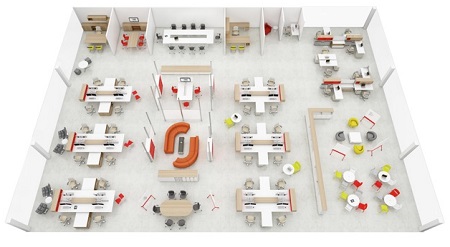Photo courtesy of Knoll, Inc. Socialization, digitalization, “connectorization,” densification, standardization, rationalization, realization, & monetization.Some say the driver for the huddle room is the coming of age of Millennials—the tech-savvy cohort born between the early 1980s and 2000—who are entering the workforce in record numbers. There is no doubt that they are active, socially engaged, and were born with a digital spoon. To meet the needs and expectations of this unique contingent, corporate offices and higher education campuses are being redesigned with open spaces, collaborative environments, and huddle spaces.
Talk to a CFO with offices located in New York, London, Singapore, or many other major metropolitan areas around the world, and the discussion is a lot less cozy. It’s driven by the bottom-line. Skyrocketing real-estate prices have effectively broken down the walls of personal offices, and decreased the amount of square footage of office space per employee leaving architectural designers, facility and HR managers, department heads, technology teams and many more to figure out how to keep the peace, while increasing harmony and productivity.
Whether it was the chicken or the golden egg that drove the huddle space trend, 2016 holds the promise of refining these spaces based on understanding human behavior, spatial considerations, technology needs, and measuring the ROI—in other words, true harmony.
The Top New Huddle Space Product for 2016
The top “new product” for 2016 huddle spaces is not new at all. Flying in the face of fiscal responsibility, ad hoc, and huddle spaces have largely gone unmeasured for utility and efficiency leaving stakeholders up and down the chain in the dark. Dan Jackson, Crestron’s research and development manager, simply stated: “Would you ever put an unmanaged Ethernet switch in your infrastructure? You have no insight as to what’s going on, and all of a sudden things break, and you now have very expensive salaries that are idling. Think of this infrastructure in the same way you think of your network infrastructure. Why would you ever put something out there, that you don’t know what it’s doing?”
Standardization continues to be critically important for large organizations. “It helps nobody if you have a lot of disparate pieces here-and-there. I don’t want my large rooms to operate differently than my small rooms,” Jackson explained. “People unplug things because they are just trying to get their life done. They stay unplugged because no one knew they were unplugged, and you end up with rooms that are considered ‘broken.’”
Connecting ad hoc rooms to a management system might sound counterintuitive, but AMX by HARMAN vice president of Product Management, Shaun Robinson, agreed. “It’s not just about measuring the technology being used, but the space utilization. Putting some about metrics around that will help technology and facilities managers utilize information to improve the workplace and make the best use of resources,” Robinson explained. “The number one cost in any enterprise is the people—human capital, and the second is property.”
Time is money
Employees waste a lot of time trying to locate an open meeting room; this is exacerbated by the decreased ratio of private offices per employee. Integrating huddle spaces into an overall room scheduling system that can be accessed from the desktop or mobile device via an app will not only save time, but increase satisfaction.
When it comes to ad hoc and huddle spaces in higher education, Gina Sansivero, FSR’s director of business development, Education, said, “Unlike the corporate market, these rooms can be used for longer periods of time. Sometimes these spaces have to be reserved in advance, for schools that have limited supply and high demand.” As the trend toward digitizing libraries increases, Sansivero added, “Instead of being a quiet area for independent students, some library floors will be buzzing with engaged, collaborative pods of students.”
Increased level of collaboration
Having the ability to collaborate with remote locations using unified communications (UC) applications is an increasing request. Extron director of Product Marketing Joe da Silva, suggested, “By incorporating a dedicated PC, camera and USB bridge within the space, AV sources can be captured and sent through the UC application on the PC and replace video conferencing systems. This transitions huddle spaces from individual collaboration from each device to true group collaboration within the room that can be extended across the enterprise and beyond.”
Black Box director of product marketing, Conference Rooms and Classrooms, Dan Vorhes noted, “Our customers are looking for more advanced features such as live annotation, the ability to save the composite view or everyone’s contribution, and even to go back and see things, which have already been presented.”
Connectivity
Where possible, Vorhes encourages users to think about huddle spaces as “transitional spaces.” They will change as technology changes. Bandwidth demands are increasing and as a result we see increasing Internet download speeds to the end-user. Hardware and software companies are taking advantage of that additional capacity by constantly innovating in this space. When possible, think about future needs and plan your infrastructure purchases to meet them.
If you want robust reliability, most would agree each space should still have wired solutions. “Something that is very exciting for everybody is USB 3.0 and USB-C as far as just the ‘connectorization,’ and being able to get audio and video out over a true, and universal connector,” said AMX by HARMAN’s Robinson. “We’re seeing it in a few laptops now, and we’ll see more over time. As we look to 2016 and especially into 2017 as they start proliferating laptops, I think is going to really help in the huddle space. Laptops will still have HDMI ports and DisplayPorts on them, but over time they will start dropping those video connectors.”
Huddle space security tips and considerations
“From an AV manufacturer’s perspective we get very jazzed about delivering great experiences, having pixel perfect resolution, and perfect, perfect audio,” Robinson said. “From an IT perspective they are less concerned about a perfect experience, and more concerned with the security profile of the device, reliability, and whether they can manage it like they can manage IT equipment.”
- The goal of a huddle space is to make it easy for the user, but that comes with caution. Here are a few tips and considerations.
- Does the user need to be connected to the network?
- The safest scenario is a wired connection using HDMI or VGA from the PC to the display, and completely off the network.
- On the network? Then validate: Ask the AV manufacturer if the gear intended for the huddle space has enterprise-grade security features. Treat the networked AV device the same as an IT product, otherwise it creates a potential vulnerability.
- If the AV presentation device is to be managed by software, and tracking utilization, it will need to be on a network.
- An option is to incorporate a VLAN and isolate the networked AV equipment in various spaces away from the rest of the network. In this scenario users won’t be able to access data off the corporate network.
- Tiered Access: Huddle spaces that are closer to the office entrance might be designated with guest Wi-Fi, and not connected to the company network. As huddle spaces move further into the environment, that’s when each type of space might be granted different levels of network access.
- Facing reality: A pixel perfect experience is less important than the security of the enterprise network.
Physical Huddle Spaces: Getting Started
As the design and use of huddle spaces has evolved from tossing any display on the wall, a Wi-Fi connection and a couple of chairs in a room, Middle Atlantic Products director of Product Management Tim Troast, suggested some general rules to keep in mind.
Ratio to Huddle Spaces Per Office:
One huddle space for every 10 employees in an open office, to every 20 people with private offices
Room Size:
20- 25-square-feet per person
Proper sizing of furniture
● 24-inch of linear space per person
● 48-inch minimum between table and wall, 60-inches recommended
● 29-inch surface height (+/– one-inch)
Connectivity & Storage
● Provide secure wired and wireless connections and reliable support w/ proper power and thermal management.
● Locate in-the-table support system, under the work surface, or in the wall.
● Fewer rack units required, if at all.
Display Considerations
● Display Height: 48-inches from the floor
● Display Size: Height should be between 4 and 8 times the length from the furthest seat at the table
● Tip: Angled tables work better for videoconferencing
Furniture equipped for huddles
Office and campus furniture designers are among the first to help individuals adapt to evolving environments. Known for designing furniture that integrates technology, Steelcase’s director of Research Communications Chris Congdon said, “Our most recent research is centered on how understanding neuroscience can help us design environments that help workers Think Better. Huddle spaces are a key part of activation, one of the three brain modes. Workers need areas to connect with coworkers, but also need other spaces that provide opportunities to rejuvenate or focus.”
Furniture design company Knoll is seeing less physical integration of technology hardware into furniture and other more permanent architectural elements. “Within shared spaces, we continue to find an emphasis on more user adaptability—lightweight, mobile chairs and tables, a high degree of personalization and customization—as well as attention on creativity—writeable surfaces and pin-up walls constructed of felt and other non-traditional materials,” said Knoll director, Workplace Research and Strategy, Kylie Roth. “Additionally, there has been an upsurge of spaces that have a residential look and feel and then spaces with uniquely branded identities that represent the culture of the organization.”
NOTABLE & NEW HUDDLE SPACE SOLUTIONS TO CONSIDER

AMX by HARMAN Sereno Video Conferencing Camera
“Sereno was developed specifically for the huddle space when we saw the way these spaces were being designed,” said Harman by AMX vice president, Product Management Shaun Robinson agreed. “The display is on the wall, and the tables are being push right up against the wall. That’s great for a face-to-face experience, but when you bring in webconferencing it’s a challenge because the people at the front of the table, closest to the wall do not get seen.” Generally PTZ cameras, and cameras that were designed to put on the top of a monitor don’t have a wide enough viewing angle. “We designed a product specifically for the huddle problem so people can have a great webconferencing experience.”
Sereno includes an ultra-wide field of view to allow everyone sitting in just about any sized room, large or small, to be easily seen on the other end of the conference. Additionally a swivel mount was integrated to allow the camera to easily be angled towards any one area of the room. To safeguard meeting room privacy, Sereno features mechanical video and audio shutters to protect what can be seen and heard in a meeting room.
MORE INFO: www.amx.com

Biamp Systems Oreno Suite
Biamp Systems Oreno Suite control solution provides greater ease-of-use, deployment simplicity, and the ability to control any Biamp Tesira-equipped conference room via mobile devices. Ideal for standalone or multiroom conference settings using Tesira or TesiraFORTÉ, the Oreno suite allows participants to lock access to specific conference rooms during a meeting, place calls, and recall presets from Web-enabled devices.
To expedite the creation of the user interface, the Oreno Creator tool provides a simple UI builder, which uses drag-and-drop tools and pre-built templates allowing for end-user customization. The Oreno Manager allows control to be passed to the end-user. Deployed onsite on a Windows PC or virtual machine, Oreno Manager provides systems administration tools and network management capabilities. Running in the browser of Web-enabled devices, the Oreno UI provides complete mobile control of a room’s audio functions without the need for any software to be installed on the user’s personal device.
MORE INFO: www.biamp.com
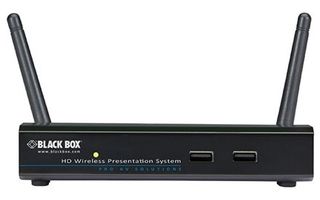
Black Box Suit of Wireless Presentation Products
Black Box Suit of Wireless Presentation Products simplifies wireless presentation, and improves collaboration. With high-performance wireless presentation tools from Black Box, you get super versatility, easy setup and management, security, and more. Benefits include: Improve collaboration: several users can access the system at once, making it a great system for conference rooms, classrooms, and lecture halls; Eliminates cable clutter: Turn your wired HDMI/VGA projector display into a wireless one; Display from any device: Use tablets, smartphones, or laptops to present, collaborate, and share content; 4-to-1 screen distribution: Show four sources at the same time on one screen.
MORE INFO: www.blackbox.com
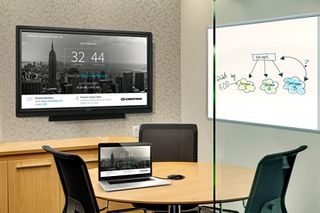
Crestron PinPoint Proximity Detection Beacon
“We’ve crafted an interface that goes up on the big screen in the room that we’re calling the PinPoint room experience,” said Crestron research and development manager, Dan Jackson. “The concept is that you should be able to walk into these rooms, and instead of being left with a black display, maybe a cable on the table, or maybe nothing, and not know what’s going on; what if when you walked into the room, the display was on, and it showed you what meeting room it was, who had the meeting room scheduled, and is it free, can just walk in and I use it, or maybe I am in the wrong room? Let’s put the relevant information up there, and let’s also put up the information on how to connect. Although there’s an HDMI cable at the table, here’s the wireless information to connect. Let’s make it a good experience rather than a confusing one, which is what happens in 90 percent of the huddle rooms out there today. The second piece of this is the PinPoint mobile app, which allows you find, and book meeting spaces from your phone. For us that was big, because people live their lives by the mobile devices. What if, to go find a meeting space you didn’t have to crack open your laptop, and put 20 different rooms in to see which one is free? What if I could just hit a couple of buttons and go, ‘oh, this one room down the hall is free, so I can go in there for 15 minutes?’”
MORE INFO: www.crestron.com
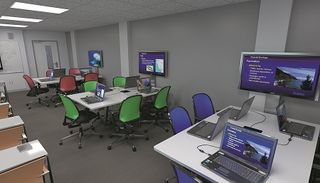
Extron TeamWork
Extron TeamWork is designed to work with virtually any classroom or business furniture system, new or currently in use. TeamWork systems are easily tailored to fit specific collaboration requirements, for up to eight users, in three easy steps. The online TeamWork System Builder quickly steps you through the creation of a custom TeamWork system. Choose from a wide range of Extron products to select the switcher, enclosure and "Show Me" cables or Retractors, and IP Link control processor that are best suited for your collaboration environment. There are many Extron products suitable for TeamWork applications. Pre-configured TeamWork system packages, for four to six users, are also available for fast implementation with minimal setup.
To start the TeamWork system, simply connect one of the system's "Show Me" control cables to the video output on your device. As soon as an active signal is detected, the display will be powered on. By pressing the "Share" button on your "Show Me" cable, the button lights and the switcher automatically selects the appropriate input. When you’re done, simply disconnect your laptop and walk away. An integrated inactivity timer automatically turns off the display after a predetermined time period.
MORE INFO: www.extron.com
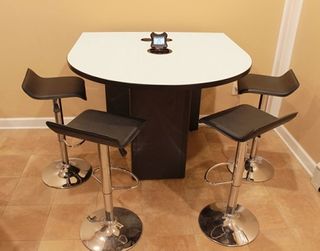
FSR MiniVU
MiniVU, FSR’s newest addition to its HuddleVU collaborative learning line, offers a complete packaged solution that incorporates multi-faceted functionality into elegant form from a compact footprint. MiniVU allows two to four users to share and view their laptops, tablets, and smart phone screens on a main display, delivering an ideal environment for small group study areas or a convenient break out space in large, open classrooms. Available in counter or table height, with a standard or custom finish, MiniVU integrates all the technology necessary for quick start up and intuitive switching. Installation is simple with hardware included and no software or programming required.
MORE INFO: www.fsrinc.com
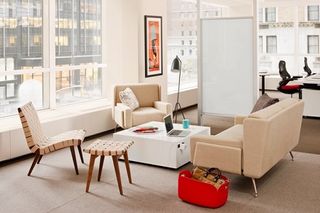
Photo credit: Photo courtesy of Knoll, Inc. Knoll Power Cube
The KnollExtra Power Cube is a lounge table that does double-duty as a digital charging hub and an analog communications tool.
Power Cube brings easy access to power to shared spaces, because everyone needs a place to plug in when they’re on-the-go. With whiteboard writable surfaces on all sides, Power Cube encourages the sharing of ideas, making it great for informal team meeting areas. The clean-lined design fits in with any aesthetic, from the distinctive to progressive.
MORE INFO: www.knoll.com
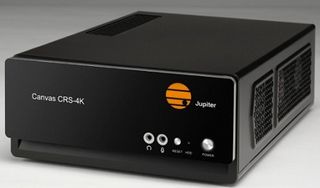
Jupiter Systems
Jupiter Systems’s Canvas CRS-4K is a conference room system in a small, quiet box that enables powerful Canvas collaboration for teams in conference rooms and huddle rooms. Running the Canvas Client, CRS-4K allows teams to share live video, real-time data, documents, application screens, and presentations with remote users in a rich collaborative environment. The CRS-4K supports up to four 1080p HD displays or a single 4K Ultra HD display, allowing even the smallest huddle room to have Canvas on the wall for powerful, collaborative teamwork. The CRS-4K is equipped with Jupiter’s SimpleShare technology, which makes it possible for users without Canvas to share their laptop screens easily and instantly with local and remote Canvas users. With SimpleShare, Jupiter’s WebRTC implementation, any laptop can be a Canvas source without downloading software, connecting cables, or attaching dongles. The CRS-4K supports Canvas 3.0, the latest version of Jupiter’s collaborative visualization software and its new features including a shared voice chat room, Microsoft Lync integration, and support for shared video and audio with SIP-based conferencing systems. A multitouch web-based tablet interface makes previewing video and manipulating canvases easy.
MORE INFO: www.jupiter.com/solutions/canvas
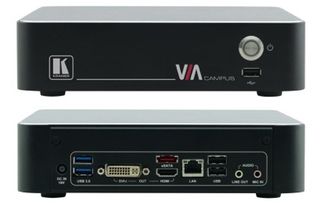
Kramer VIA Campus
Kramer recently added VIA Campus, a wireless VIA solution for education and training, to the VIA family of wireless presentation and collaboration solutions.
With VIA Campus, students can connect any laptop or mobile device and present instantly to the main display, view the main display on their screen, edit documents together in real time, and use the main display as a digital whiteboard. Both teachers and students can share any size file and stream full-frame HD video.
VIA Campus e-exams feature enables teachers to give interactive, multimedia tests and get immediate feedback. The e-Polling solution lets teachers conduct instant surveys of student knowledge and opinion to help stimulate relevant discussion and debate.
This Bring-Your-Own-Device (BYOD) solution also features on-screen collaboration, Mac/PC and iOS/Android mirroring, and third-party apps for remote learning and collaboration.
MORE INFO: www.kramerus.com
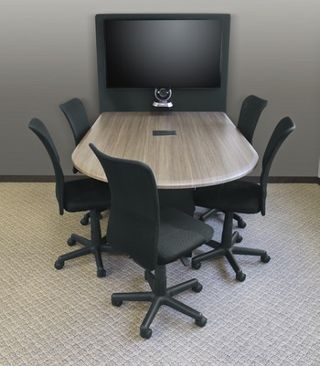
Middle Atlantic Hub
Middle Atlantic’s Hub is a technology-ready, all-in-one furniture solution for collaboration spaces that is designed to maximize equipment storage and cable management. Created for easy integration, Hub is ideal for unified communications and collaboration environments including huddle spaces, active learning spaces, and videoconferencing applications.
Each Hub is comprised of a tabletop featuring a Wiremold InteGreat table box providing power and data for easy BYOD integration. These are supported by Middle Atlantic’s TechPed technology pedestal, featuring integrated Lever Lock plates for small device mounting and two Wiremold HDMI cable retractors to facilitate connectivity for anyone at the table. Shipping fully assembled for easy integration, the TechPed also includes 4RU of space with room for additional cable retractors and power distribution with a four-outlet power strip. In addition, Hub includes a wall-mount bracket for flat-panel displays with an additional four-outlet power strip that mounts to the table bracket for connections close to the display. An optional tower, available in black or white, can be used to mount displays directly to the table in a freestanding configuration.
More Info: www.middleatlantic.com
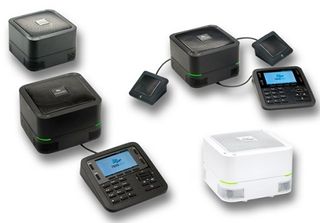
Revolabs FLX UC Conference Phones
Revolabs FLX UC product family of conference phones provides users with a series of standalone devices made to satisfy virtual meeting requirements in offices, huddle rooms, and medium- to large-size conference rooms. The phones feature powerful, high-fidelity audio capabilities that combine premium tweeter and mid-woofer elements, four integrated microphones, and audio technology such as acoustic echo cancellation, wide frequency response, and full duplex support. The cost-effective FLX UC 500 USB speakerphone, users gain higher power than typical USB audio devices, which allows users to easily connect the unit to any PC, Mac, or Chromebook for use with communication applications such as Skype, Microsoft Lync, Vidyo, WebEx, and many others.
More Info: www.revolabs.com
Steelcase
Steelcase media:space
Based on Steelcase extensive research into work, workers, and the workplace, media:scape encourages content sharing and collaboration. It’s easy to use, supports the work of individuals, pairs or groups, and integrates seamlessly into existing IT platforms.
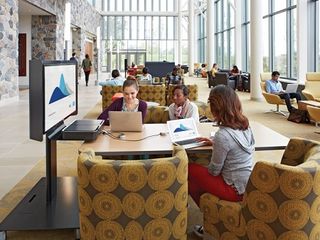
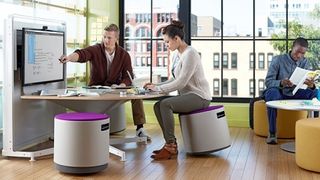
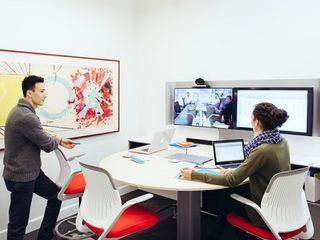

Photography courtesy of Steelcase
At the core of Steelcase’s media:scape range of scalable collaboration settings is its virtual PUCK which allows meeting participants to share content wirelessly from a laptop, maintaining the simple “Open. Connect. Share.” experience of media:scape. The app seamlessly integrates with a media:scape setting, enabling information-sharing from any participant, anywhere in the room, with a simple click of an icon or touch of a physical puck.MORE INFO: www.steelcase.com
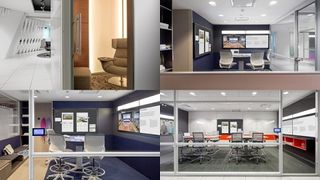
CONCEPT: Steelcase Intelligent Office
Steelcase new concept products for the Intelligent Office, a future workplace which integrates technology into places that can enhance human interactions at work and give workers more control over key sources of distractions that impact performance such as noise, interruptions, lighting and temperature control. These concepts represent Steelcase’s explorations of how work environments in the future might better address a range of distractions and obstacles at work that leave people feeling overwhelmed and less productive. The concept integrates sensing devices into the work environment that gather and aggregate data and learn over time what people want and need.
More Info: http://www.steelcase.com/Cindy Davis is AV Technology magazine's contributing editor.
